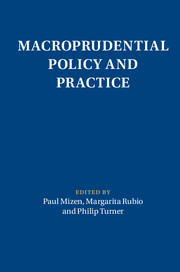Book contents
- Macroprudential Policy and Practice
- Macroeconomic Policy Making
- Macroprudential Policy and Practice
- Copyright page
- Contents
- Contributors
- Introduction
- 1 The Macroeconomics of Macroprudential Policies
- 2 A Liquidity-Based Approach to Macroprudential Policy*
- 3 Financial Intermediation and Monetary and Macroprudential Policies
- 4 The New Art of Central Banking
- 5 The Macroprudential Countercyclical Capital Buffer in Basel III
- 6 On the Use of Monetary and Macroprudential Policies for Small Open Economies
- 7 Capital Flows and Macroprudential Policy
- 8 Macroprudential Policy in a Globalised World
- 9 Systemic Risk of European Banks
- 10 Macroprudential Tools of Systemic Risk Analysis
- 11 When Is Macroprudential Policy Effective?
- 12 Macroprudential Policy
- Index
- References
10 - Macroprudential Tools of Systemic Risk Analysis
Published online by Cambridge University Press: 09 August 2018
- Macroprudential Policy and Practice
- Macroeconomic Policy Making
- Macroprudential Policy and Practice
- Copyright page
- Contents
- Contributors
- Introduction
- 1 The Macroeconomics of Macroprudential Policies
- 2 A Liquidity-Based Approach to Macroprudential Policy*
- 3 Financial Intermediation and Monetary and Macroprudential Policies
- 4 The New Art of Central Banking
- 5 The Macroprudential Countercyclical Capital Buffer in Basel III
- 6 On the Use of Monetary and Macroprudential Policies for Small Open Economies
- 7 Capital Flows and Macroprudential Policy
- 8 Macroprudential Policy in a Globalised World
- 9 Systemic Risk of European Banks
- 10 Macroprudential Tools of Systemic Risk Analysis
- 11 When Is Macroprudential Policy Effective?
- 12 Macroprudential Policy
- Index
- References
Summary
This chapter is aimed at presenting tools of systemic risk analysis used as a part of stress testing framework and their application to address systemic risk questions facing macroprudential policy decision makers with special attentions to problems present in the Polish banking sector. In the first part of the paper alternative definitions of the systemic risk are described. Then alternative tools of systemic risk measurement and analysis are presented. The reference network model is integrated with stress testing framework to empirically evaluate impact of the systemic risk on the Polish banking sector. Gained results of the research show that, in general, banks operating in Poland are immune to endogenous and exogenous sources of systemic risk and this type of risk is not a source of instability for the domestic banking sector. However some shocks emerging (inter alia) from the structure of the Polish banks’ capital ownership and characteristics of the mortgage credit portfolio should be carefully monitored in the future.
- Type
- Chapter
- Information
- Macroprudential Policy and Practice , pp. 225 - 247Publisher: Cambridge University PressPrint publication year: 2018
References
- 2
- Cited by



